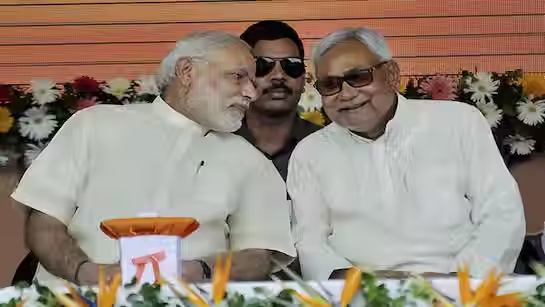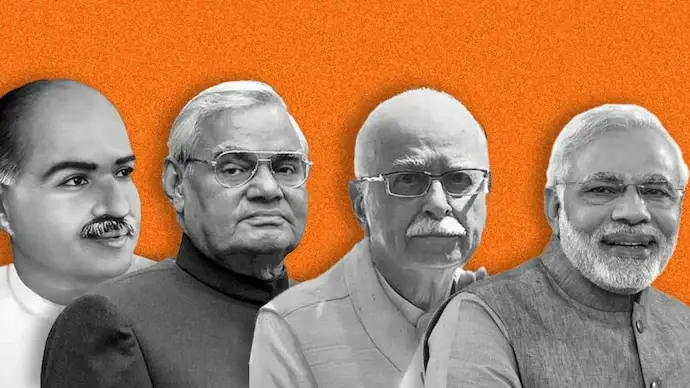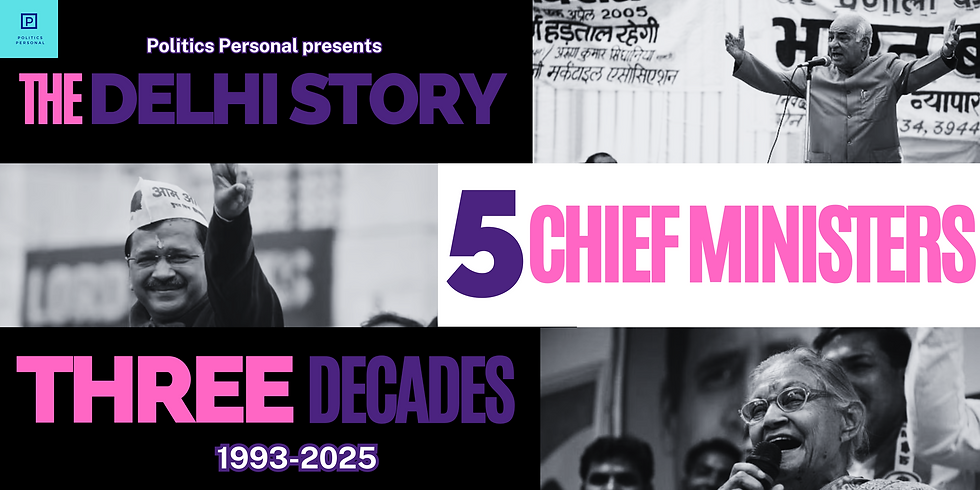The Era of BJP Dominance in Indian Politics: 2012 onwards
- Jagneet Singh

- Jun 12
- 5 min read
Updated: Jun 13
Since 2012, Indian politics has witnessed the rise of the Bharatiya Janata Party (BJP) to a position of unprecedented electoral dominance. Whether in national elections for the Lok Sabha (Parliament’s Lower House) or in numerous state Vidhan Sabha (Legislative Assembly) polls, the BJP has frequently emerged as the party to beat. This period has been defined by the BJP-led National Democratic Alliance (NDA) securing repeated mandates at the centre and expanding its political footprint across Northern, Western, Eastern, and even parts of Southern India.
This comprehensive research article analyses electoral data from 2012 to 2025—sourced from the Election Commission of India—to understand how the BJP became the most electorally successful party of the past decade. We examine Lok Sabha victories, state assembly outcomes, voter behaviour, party performance, and coalition dynamics across India's diverse states.
Lok Sabha Elections: The Trifecta of 2014, 2019, and 2024
Year | BJP Seats | NDA Seats | Vote Share (BJP) |
2014 | 282 | 336 | 31.0% |
2019 | 303 | 353 | 37.4% |
2024 | 240 | 293 | 36.6% |

Despite a dip in 2024, the BJP remains the single largest party and head of the ruling alliance, reflecting a strong national presence. Its performance is bolstered by a consistent support base across North and Central India and growing outreach into the South and East.
Understanding the Engine of BJP Dominance

The success of the BJP can be attributed to a blend of organisational strength, ideological clarity, strategic leadership, welfare politics, and adaptability in alliance-building. The integration of digital campaigns, grassroots cadre networks, and issue-based mobilisation—especially on nationalism, Hindutva, and welfare—has enhanced its electoral reach.
BJP's Electoral Geography (2012–2025)
We break down BJP’s dominance regionally, including the most recent election results and voter trends in each state.
Northern India

Uttar Pradesh
BJP's biggest stronghold, contributing significantly to its Lok Sabha tallies. The drop from 62 seats in 2019 to 33 in 2024 signals a drop, but its assembly dominance (255/403) remains intact. Dalit-Muslim alliances under the INDIA bloc, especially SP and INC tactical alliances with the BSP collapsing and its voter shifting to the INDIA bloc, hurt BJP. Yet, the BJP retains an edge in urban pockets and Brahmin and non-Yadav OBC support.
Delhi
BJP stormed back to power in the 2025 Assembly elections after nearly three decades. Riding on anti-corruption messaging, civic administration control (MCD), and AAP leadership's credibility crisis, BJP won 48 of 70 seats. The narrative of clean governance, infrastructural promises, and nationalism found resonance among first-time voters.
Haryana
After a narrow win in the 2024 Assembly, BJP's vote share slightly dipped, reflecting rural discontent, especially among Jats and farmers. Still, BJP’s booth-level management, female-centric schemes, and urban governance focus enabled retention. JJP’s collapse helped consolidate votes.
Punjab
Despite weak performance, BJP’s strategic shift toward urban Hindu voters and Dalits shows recalibration. The ongoing friction between AAP and Congress opens space for BJP to act as a third pole, especially in Doaba and Majha regions.
Western and Central India

Gujarat
Gujarat continues to be BJP’s model state. With a clean sweep in Lok Sabha and a historic 2022 Assembly win, the state's voter base remains loyal. Hindutva, governance record, and BJP's booth power continue to dominate over a fragmented Congress.
Madhya Pradesh
The state showcases BJP’s welfare governance playbook. Ladli Behna Yojana, free ration schemes, and the Modi-Chouhan double engine image helped the BJP to a massive Assembly win (163/230). Lok Sabha sweep followed in 2024.
Maharashtra
Initially weakened by the Maha Vikas Aghadi, the BJP rebuilt itself through engineered alliances. After a Lok Sabha dip, its comeback in the 2024 Assembly (235/288 with allies) reaffirms its political manoeuvring capability. The Fadnavis-Shinde-Ajit Pawar alliance ensured caste/community micro-mobilisation.
Chhattisgarh
BJP's 2023 Assembly win marked a comeback driven by anti-incumbency and tribal outreach. In 2024, it regained lost LS ground. Leadership clarity and local-centric campaign designs helped overcome Congress's rural grip.
Southern India
Karnataka
BJP retains national-level strength but lost state power to Congress in 2023. Lok Sabha tally (17/28) held steady in 2024. The Lingayat vote, BJP’s Hindutva base, and PM Modi’s charisma remain its core strengths. BJP eyes resurgence through youth and urban outreach.
Telangana
Post-BRS decline, BJP’s leap to 8 LS seats marks its best performance. Issues like corruption, urban governance, and religious polarisation played to BJP’s favour. BJP now consolidates as principal opposition.
Kerala
BJP opened its Lok Sabha account with Suresh Gopi’s win in Thrissur—a milestone. The party’s campaigns targeting minority appeasement and promoting development-orientated politics are slowly resonating.
Tamil Nadu & Puducherry
Gains remain symbolic but important. With AIADMK weakened, BJP positions itself as the alternative to DMK, tapping into middle-class and urban Hindu voters. Puducherry shows a stronger BJP base with assembly and civic control.
Eastern and Northeastern India
West Bengal
Despite seat losses (12 in 2024), the BJP remains the principal opposition. Its strength lies in North Bengal, border districts, and migrant labour communities. Post-poll violence, NRC-CAB debates, and cultural nationalism define BJP's fight in Bengal.
Odisha
In 2024, the BJP nearly swept the LS polls. With Naveen Patnaik’s BJD weakening and 2024 Assembly elections, victory has solidified the BJP's presence in the state. Its tribal outreach, promotion of Odia pride within nationalism, and anti-incumbency momentum are critical levers.
Jharkhand
INDIA bloc’s Assembly win masks BJP’s ground presence. In tribal belts, BJP’s pitch for religious codification (Sarna), economic revival, and nationalism appeals to urban Adivasi youth. Anti-corruption and security remain key issues.
Northeast
BJP continues to lead coalitions in Assam, Tripura, Manipur, and Arunachal. With infrastructure development, cultural integration, and welfare rollout, the BJP has turned the Northeast from a Congress bastion to an NDA fortress. However, Christian-majority states like Nagaland and Meghalaya demand a more sensitive approach to identity and autonomy.
Emerging Trends and Voter Shifts

Women-Centric Welfare: From Ujjwala to Ladli Behna, BJP’s targeted schemes have improved its female voter appeal.
Digital Campaigning: BJP's dominance in social media outreach has redefined electioneering—WhatsApp groups, targeted micro-influencer networks, and digital rallies have become norm-setting.
Youth Mobilisation: Nationalism, startups, army recruitment schemes (like Agnipath), and skill programs attract first-time voters.
Caste Realignments: BJP’s work with non-Yadav OBCs, non-Jatav Dalits, and tribals continues to reshape electoral dynamics.
Religious Polarisation vs Welfare Balance: The party balances Hindutva messaging with pro-poor narratives, appealing across ideological divides.
Bihar: Key Battleground for 2025

Bihar is one such place in the Hindi Heartland where the BJP is yet to dominate on its own self without the allies. It will be a test of the BJP-RSS machine and mobilisation, and also how JDU and Nitish Kumar helps or damages the prospects of the NDA there. There is a feeling of 'Nitish Fatigue' also after almost 25 years of his government in the state. Plus, recent surveys and polls are showing RJD to be the most popular party and its leader, Tejaswi Yadav, to be the 'Neta number one' in Bihar at the moment. Challenges for the BJP would be: can it dominate by itself, can it break the Muslim-Yadav consolidation, and can it consolidate the other backward classes in its favour?
Conclusion: Will the Dominance Sustain?
From 2012 to 2025, the BJP has built the largest, most versatile electoral machinery in Indian political history. While it continues to dominate national politics, cracks have appeared in rural belts and certain states. Its ability to adapt, respond to local issues, and recalibrate alliances will determine whether the party can maintain this dominance through 2029 and beyond. The next few years will be a test of resilience, governance, and innovation for the BJP.





Comments